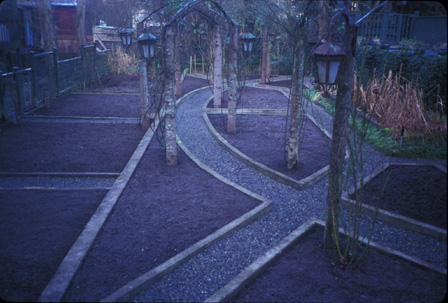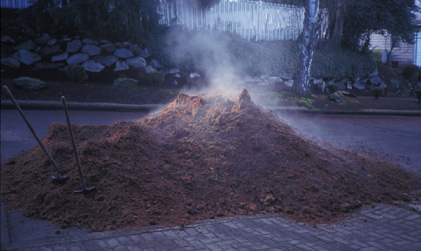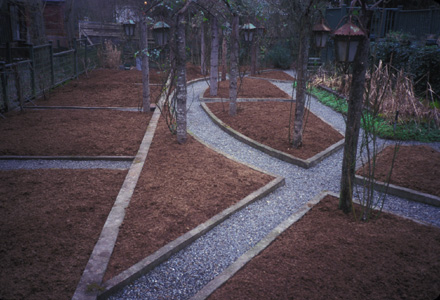
|

|

|
Garden beds before and after 10 cubic yards of composted dairy manure was used as a mulch, January 2000
|
| Soil is Alive |
| Soil is alive. This is not to say that everyday dirt is a living organism, but that humus-rich topsoil or compost indeed so teems with life that it is thereby potently active. The soil in an old-growth forest or in an established organic garden contains innumerable micro-organisms, fungal species, insects, worms, etc. The way these beings interact and affect plant life is largely unknown to science. The complexity is too great for our comprehension. A good way to embrace vividly the concept of soil as life, is to imagine deep rich dark soil someplace where plants and wildlife abound and thrive --then contrast this picture by visualizing the dry shifting sands of a desert. Just as adding water to sand doesn't enable it to support a garden, so adding mere peat and water doesn't --what's needed for perfect soil is a whole web of minerals, organic matter, soil flora and fauna. |
| For those of us not living on river floodplains or other exceptionally rich land, we should know how to promote optimal soil health, therefore plant health. Compost is the gardener's wealth, and antidote to poor soil. Nature's built-in processes break down all organic matter into smaller and smaller pieces, eventually molecular. Nature doesn't make compost heaps or bins, doesn't turn the piles, but just lets everything fall and rot where it will, at its own pace. Thus there is an endless, gradual process of recycling organic debris into life-giving earth. |
| The result of a mature, balanced soil becomes a state wherein nutrients, moisture, oxygen, and beneficial fungal organisms are all ideally suited to nurturing plant growth. There is no waste. There is no villain. Instead there is a dramatic, complicated interplay at work. Evolution crawls on at its unhurried pace, and only periodic catastrophes occasion what we might call time-outs or intermissions: volcanism, fires, flooding, as well as human atrocities such as bomb blasts, toxins, bulldozing, and similar horrors. |
| Seattle residents, for the most part, have soils relatively low in organic matter. Whether the soil is sandy, clayey, or a blend, most of us have a very shallow topsoil of dark matter, on top of glacial till. If we are lucky our soil is merely sterile; some of us must endure sterile compacted soil --epitomized by blue clay. In any case it is our thin layer of dark topsoil that we must build, since in it occurs most of the biological activity, from root growth, gas and nutrient exchange to the amazingly diverse microbial activity. Whether our soil is covered with a lawn, a vegetable garden, a flowerbed, or something else --doesn't matter. As long as there is exposed ground, we can help. |
| Not only will our composting actions benefit plant health and productivity, we can also indirectly minimize soil erosion, water runoff, and can even help stave-off the greenhouse effect by altering the carbon-oxygen exchange ratio. According to Michael Pilarski, editor of Restoration Forestry (1994), organic soil amending, if widely practiced, can ultimately "lead to reoxygenation of the troposphere, increase stratospheric ozone, draw down atmospheric carbon dioxide and stabilize the climate." In other words, help keep earth habitable for people. |
| Since gardeners love to show other people their produce, their favorite plants, and seek commiseration about their problems, it is no wonder they also like discussing compost. Those with a good compost system are happy, those without seek as much. I have composted plant debris for almost 20 years, and worked with a variety of methods. The simplest way is to just spread fallen leaves, clippings, and sweepings onto a plot of ground that has need of soil enriching. In short, mulch the soil. This is good if the soil would otherwise be bare or weedy. You can also smother an undesired lawn, or even a bed of low junipers this way. Just dump truckloads of chipped-up trees and grass clippings, and gradually your steaming mass of plant material decomposes into moist black humus. Then you can grow zucchini or whatever to astonishing magnitude. |
| For most of us, a compact, deep pile or bin, or several such, is better. I have made bins out of wood, cinder blocks, wire screen, and even turned an unused doghouse on end. The pile should ideally be at least 3 feet tall and wide, consist of a balance of green and brown matter, evenly moist, and should get turned for aeration occasionally and wetted as needed. Truth is, such tinkering is anathema to many people, like taking out the garbage, and all it does is speed the breakdown process. You can bide your time, indiscriminately pile up your organic refuse, and it will eventually rot. Some things take longer, such as walnut shells, pine cones, chunks of wood, sword ferns, etc. But eventually the only resistors are inorganic things --bits of glass, cigarette butts, plastic, rocks and nails. |
| If you start clumsily, act uncertainly, and get uninspiring results, try to gain confidence and learn from your trials. Later on there may be real joy of making a very hot pile, of successfully composting ivy and wild morning glory, of ending up with mountains of gardener's black gold. Your plants will thank you, their vigor will improve, and you will revel in a more intimate interaction with nature. Composting involves our senses of sight, smell and touch. It makes us feel responsible and grounded. Using it is the antithesis of using herbicides and fungicides. The one path gives life, the other taketh it away. |
Seattleites are fortunate, perhaps even relatively spoiled, when it comes to composting and soil improving. We have resources left and right. The P-Patch system (684-0264) is organic, offering some three dozen in-city sites for gardening. At compost demonstration sites you can observe every imaginable style of bin, pile, cylinder, box or cone. One such site is at the extreme northeast end of South Seattle Community College (6000 16th Ave. SW); one in a prettier setting is at Seattle Tilth's site in Wallingford, at the Good Shepherd Center (4649 Sunnyside Ave. N). For over 10 years Seattle's Solid Waste Utility and Seattle Tilth have sponsored a master composters training program, and a compost hotline (633-0224). You can call the hotline with any sort of compost question. The clean green and curbside recycling programs divert yard and garden waste from the landfill and instead transform it into Cedar Grove compost (432-2395). Various carpenters manufacturer worm bins to turn home kitchen food wastes into valuable worm fertilizer. Reducing pesticide usage has several benefits, one being to protect soil health. For information contact the Green Gardening program (547-7561), sponsored by various agencies concerned with public and ecologic health. A new and rapidly evolving program is grass-clipping recycling technology, called grasscycling. This targets the mountains of lawn clippings generated every growing season. And lastly, note the unglamorous but real efforts of transforming sewage byproducts into soil improvers.
(originally published in The Seattle Weekly, December 1996)
Back |
|
|

